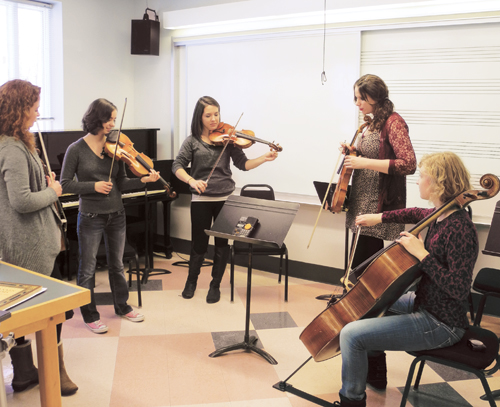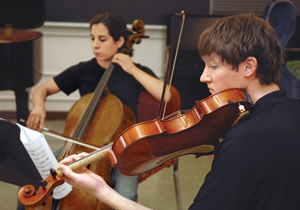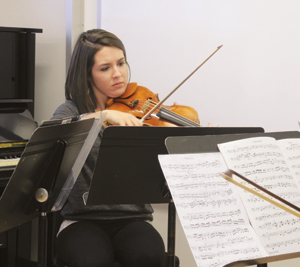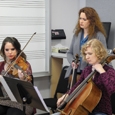
Chamber music provides an excellent opportunity for students to improve musical abilities and gain confidence. However, even good players may struggle initially without the leadership of a conductor and the support of a full section playing the same part. Before students begin work on their selected piece, some preliminary preparation and exercises will help build communication and ensemble skills and decrease frustration.
Getting Started
Copy a score for each member of the quartet and have students highlight their parts in the score. Students should use the score for silent study, with a recording, and for rehearsing tricky ensemble passages in the future. Before handing out parts, take the time to put in unified bowings. Often the first violin parts are more difficult technically than the other parts, so the student may need fingerings or extra help. Students should number the measures themselves, which saves time during rehearsals and makes them look at each line. A careful look at the whole work highlights sections that are more difficult and will require extra practice.
Students should listen to several recordings of the piece to compare tempos, dynamic range, use of rubato, and sound quality. While listening to the recordings, students can air play their parts or even quietly hum along. YouTube videos allow students to hear several versions or their own part played separately.
Before the first rehearsal, give students a list of basic questions to research:
• When did the composer live?
• When was the piece written?
• What is the style period?
• What is the form of the movement?
• What are the primary keys in the composition?
• What is the meter of the piece?
At rehearsals each member of the ensemble can share something new about the composer or composition.
Tuning
As a general rule small string ensembles tune to the cello. The cellist should check the A with an electronic tuner or reliable piano before sharing it with the rest of the group. Then the other members of the group should tune separately. After everyone has tuned, the violist and cellist should check the C strings, and the violinists should check the E strings.
Warmups and Scales
 It takes time for newly formed groups and inexperienced chamber players to become comfortable with prolonged eye contact, breathing, and leading an ensemble. Group scale practice is a wonderful way to establish camaraderie and comfort. It also provides an opportunity to work on sound quality, intonation, rhythm, listening skills, bow strokes, and physical communication without the pressure of reading music.
It takes time for newly formed groups and inexperienced chamber players to become comfortable with prolonged eye contact, breathing, and leading an ensemble. Group scale practice is a wonderful way to establish camaraderie and comfort. It also provides an opportunity to work on sound quality, intonation, rhythm, listening skills, bow strokes, and physical communication without the pressure of reading music. Have the students identify the primary keys found in the composition. To avoid confusion, stick to scales in one or two octaves. Start with a scale played in unison with separate bows. Rotate the leadership role so that each student has an opportunity to breathe, cue, and start the ensemble. As they play the scales together, students should focus on bow division and blend of sound. Ask students to use a full bow and try to stay in the same part of the bow as the rest of the group throughout the scale. Have students practice listening to the person directly to their left, then on their right, and across the group. Practice the unison scale forte, mezzoforte, and piano. Once students become more adept at listening to the sound of the group, play the scale as a canon, with each person starting a third apart.
The next step is to add slur patterns. Start with two-note slurs and have students place sticky notes at the exact middle of the bow. They should try to reach that point for the second note of the slur. To develop coordination and quick thinking, try such asymmetrical slur patters as two notes on a down bow and three notes on an up bow or five-note slurs.
If the group struggles to play the scale in tune together, add a drone tone. Each person should take a turn playing the drone or tuning note.
To improve eye contact and communication pass the scale around the group. Each student plays two notes of the scale and then passes it to another person. Start by passing in a planned way, either clockwise or counter-clockwise. Once the students are comfortable passing and receiving, they can pass the scale in an undetermined order, using eye contact and body language to keep the scale moving.
Another scale exercise develops communication and leadership skills. Designate one student as the leader and ask him to stand, while the others remain seated. (If the cellist is the leader, he can sit in the center of the group or on a podium.) The leader decides how to play the scale and can incorporate rubato, dynamic changes, and varied bowings or bow strokes. The physical motions should be clear and purposeful so that the other members of the group can follow.
Students should practice scales with many different characters and styles. Each member of the group should be able to cue and lead a scale with an energetic bow stroke, a delicate attack, spiccato, or with crescendos and diminuendos. Unison chords are often found in string quartet literature. Ask students to practice a scale with all down bows played at the frog. This teaches them how to execute the approach and follow through for chords without the added pressure of playing double stops.
Look at the rhythms and bow strokes that are prevalent in their composition. In the case of Haydn’s “Horseman” quartet, for example, dotted rhythms, spiccato triplets, and grace notes are found throughout. Students could practice a G-Minor scale with a dotted rhythm in a hooked bowing, or a B-flat major scale in a brush stroke, playing two, three, or four strokes per pitch.
Rhythm
Chamber music groups should work with a metronome. A good option is to hook the metronome up to speakers so everyone can easily hear it. In addition to the external metronome, create an internal metronome by having one member of the group play a consistent rhythm (all quarter notes for example) or count aloud.
Rhythmic simplification is a valuable tool when students have difficulty playing together. The first time through a passage, tell students to play only the notes on beat one and count the other beats out loud. Another option is to have one person count out loud while watching his part or the score as the rest of the group plays. Students can also practice in pairs; this allows them to pinpoint and fix rhythmic problems.
To work on rhythmic precision, practice passages pizzicato. If the passage is too fast to play pizzicato, students can tap rhythms on their hands or music stands. This is a useful rehearsal technique when students do not hear that they are not together.
Students may have trouble understanding exactly how the rhythms of the different parts fit together. Have students subdivide their parts into eighth notes or sixteenth notes, with and without the metronome. If the group subdivision is confusing, have one person provide a constant subdivision while the others play their parts. The person providing the subdivision can play fortissimo while the others play pianissimo.
Communication and Listening
 Have students sit in a circle during the first rehearsals so that they can hear and see everyone. Quartet members should switch seats every ten minutes so they have a chance to sit next to and hear every person in the group. The coach should sit or stand next to each member of the group at some point during the rehearsal. The coach can also sit in the middle of the group to work on balance and blend.
Have students sit in a circle during the first rehearsals so that they can hear and see everyone. Quartet members should switch seats every ten minutes so they have a chance to sit next to and hear every person in the group. The coach should sit or stand next to each member of the group at some point during the rehearsal. The coach can also sit in the middle of the group to work on balance and blend. To identify who has the melody, ask students to stand up when they play the melody. The cellist can lean forward or say me. In rehearsal the person with the melody can play fortissimo while the others drop to pianissimo.
Find rhythmic motives in the piece; students can pass a motive around the group as they did with scale passages. Make sure that each student plays rhythmic and melodic motives in the same part of the bow, with the same amount of bow speed, and with the same articulation.
As students become more comfortable with the piece, challenge them to look up at another member of the group at least once per measure. As passages of the music become memorized, practice without music stands. Place an item in the center (a metronome will work fine) and have students focus toward it to create a group blend of sound. For advanced listening practice, have students play while they face the corners of the room and are unable to see each other.
Performance Preparation
As the quartet prepares for their first performance, record them and listen to it together. Each member of the ensemble should take notes on what did and did not sound good. Students should offer constructive criticism and come up with creative solutions for ensemble problems.
Encourage the group to find a name. Even something as basic as “East High School Quartet,” develops an identity and personality. Students should practice walking on stage as a group, with the cellist or violist leading and the violinists coming last. As the quartet lines up to acknowledge the audience, have them use peripheral vision to bow together. To ensure that they bow for the same length of time, they should mentally say the name of the group, or an appropriate multi-syllabic word, as they pause in a bowed position. Work on leaving the stage after the performance. It looks sloppy when some members of the group stop to pick up music while others race off the stage. Have a policy and practice it multiple times. Under pressure, students will forget what they planned if it is not well practiced.
Be creative with performance clothes. Go beyond the stereotypical serious string quartet dressed in all black. Encourage students to bring some color to the performance though clothing or music stand decorations. Ask students what associations they make with the style of the piece; perhaps a certain color or style of clothing will help set the mood.
For the stage set-up, one creative idea is to have violinists and violists stand up. This gives them greater freedom of movement and assists with communication. Experiment with the viola and cello placement. The cellist might sit on a platform if some of the students stand. Often young groups achieve a better balance and blend with the cellist on the inside of the group so that everyone can hear him.
The overall goal is to be generous and communicative on stage. Students have already worked on communicating with each other; the final step is to work on communication with the audience. For dress rehearsals, quartets can practice with an audience of fellow orchestra members or parents. One idea is to place the mock audience on stage surrounding the quartet. Ultimately, remind the students to smile and enjoy the performance.






